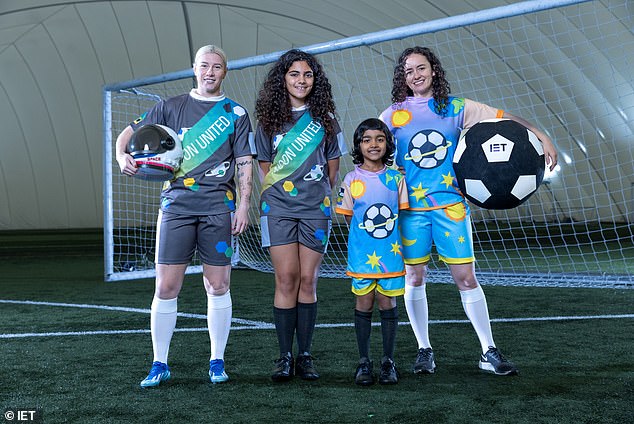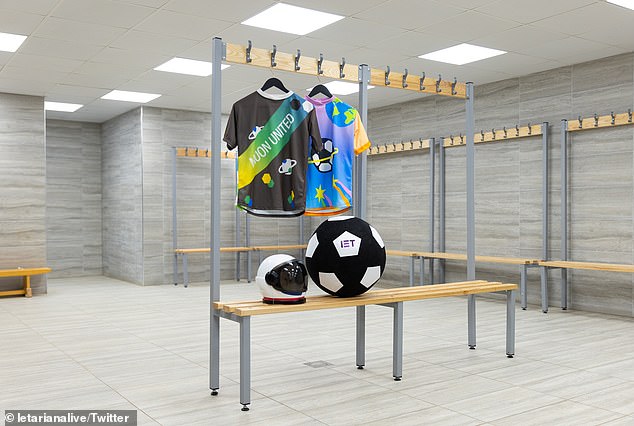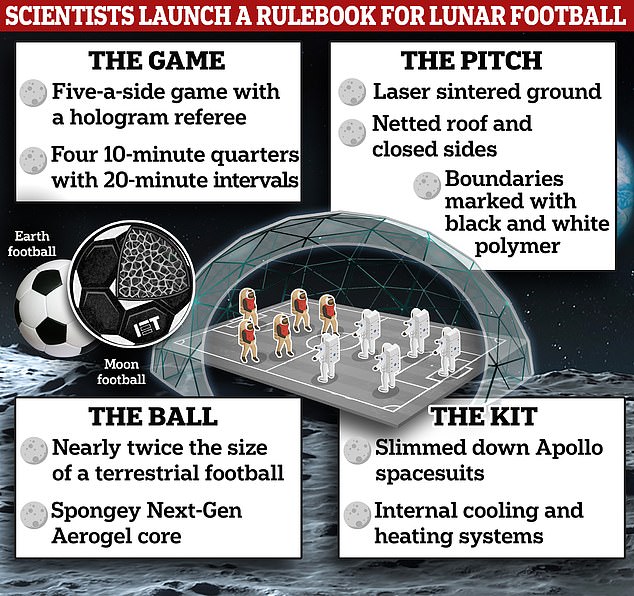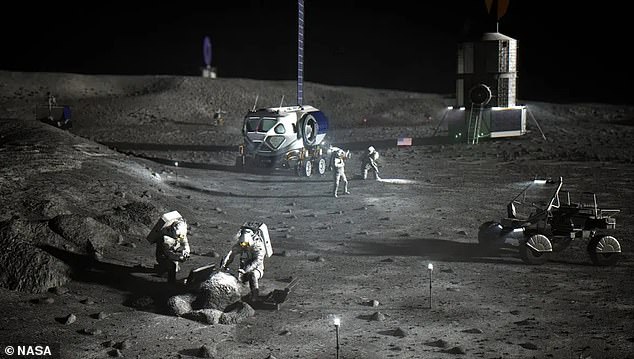Moonchester United! Scientists reveal the first ever football kits for games on the lunar surface – which they claim could be as soon as 2035
No human habitat would be complete without a place to play football – not even on the moon.
In recognition of this, experts have unveiled home and away kits for what they envision as the first ever moon football club, ‘Moon United’.
Instead of being splashed with the names of major corporate sponsors, the vibrant, space-inspired designs feature colorful illustrations of the solar system.
However, the swish kits would have to be converted into Apollo-style spacesuits if they were ever worn on the moon.
Scientists think that the beautiful game could be played on the moon as early as 2035, although it will look very different from a match here on Earth.
The winning designs should be turned into Apollo-style spacesuits with internal cooling and heating systems
The two new kit designs are the result of a British children’s competition organized by the Institution of Engineering and Technology (IET), based in London.
The winning designs – which showcase a ‘mix of striking design work and scientific thinking’ – were selected from more than 500 entries by a jury and crafted into real clothing.
Winners Erim Ali, 13, and Ishaani Nair, 7, were presented with their kits by Tottenham Hotspur striker Beth England and British aerospace engineer Sophie Harker.
“There is so much potential for technology to make things we only dream of, like playing football on the moon, a reality,” Harker said
“With imaginative, inventive children like Erim and Ishaani, I am hopeful that the next generation will be the ones to make this happen.”
Erim’s gray unisex design – the home kit – features ‘geometric, molecule-inspired shapes’ and is said to turn sweat into usable water.
Meanwhile, the more colorful away kit designed by Ishaani has a space theme, with illustrations of the sun to represent the ‘positivity of the game’ and the shooting stars representing the speed and spirit of football.
In the center is a football with a ring around the middle – a reference to the planet Saturn.

The new designs are the result of a competition by the Institution of Engineering and Technology (IET). Pictured are the young winners with professional footballer Beth England (left) and British engineer Sophie Harker (right)

The gray kit is Moon United’s home kit, while the pink/blue kit is the away kit

Experts think that the beautiful game could be played on the moon as early as 2035, although it will look very different from a match here on Earth.
If humans really set up a habitat on the moon, IET wants to establish Moon United as the very first club.
The institute already has one rulebook which outlines what the sport will look like on the lunar surface – and there are several adjustments that would be made to our beloved sport.
First, each player would have to carry their own oxygen tank, attached to their airtight Apollo-style space suit, which would have internal cooling and heating systems.
The field would be eight times smaller than that of a football field on Earth and would be surrounded by nets to prevent the ball or players from floating away.
The ball would be almost twice the size of a normal football and mainly black to contrast with the gray moon soil, which would be treated with a laser to flatten it.
The ball would also have a spongy center, since a ball filled with air would likely leak or burst due to the pressure difference between the ball and the vacuum of space.
In addition, there would be only five players on each side and instead of two halves there would be four 10-minute quarters with a 20-minute break between each quarter for the players to recover.
The offside rule would also be scrapped, which will be music to the ears of the many fans who cannot tolerate the annoying VAR checks to determine whether a goal is valid.
Moon football would also be a ‘strictly non-contact’ sport, although the lack of gravity would rule out any precise control or refined dribbling we expect from players like Lionel Messi anyway.
Although much of the IET rulebook is written in a tongue-in-cheek style, scientists are actually preparing for human life on the moon and looking at typical activities that might or might not be possible there, from growing crops to having sex.

NASA’s early Artemis missions should lay the foundation for bases on the moon later this decade (pictured is an artist’s impression)
NASA is spending billions on efforts to get humans to the moon for the first time since the 1970s — but this time to stay there.
A key part of NASA’s Artemis program is returning humans to the moon’s surface in 2025 – which would be the first time human boots have touched the moon since 1972.
Although this would only be a fleeting visit of about a week, it would lay the groundwork for lunar base construction by the late 2020s.
These would be complete with long-term living quarters and research facilities for explorers to study the moon’s rocks.
Ultimately, the moon could be a thriving metropolis, complete with hotels and other businesses catering to “space tourists” who pay thousands of dollars for an exclusive vacation.
